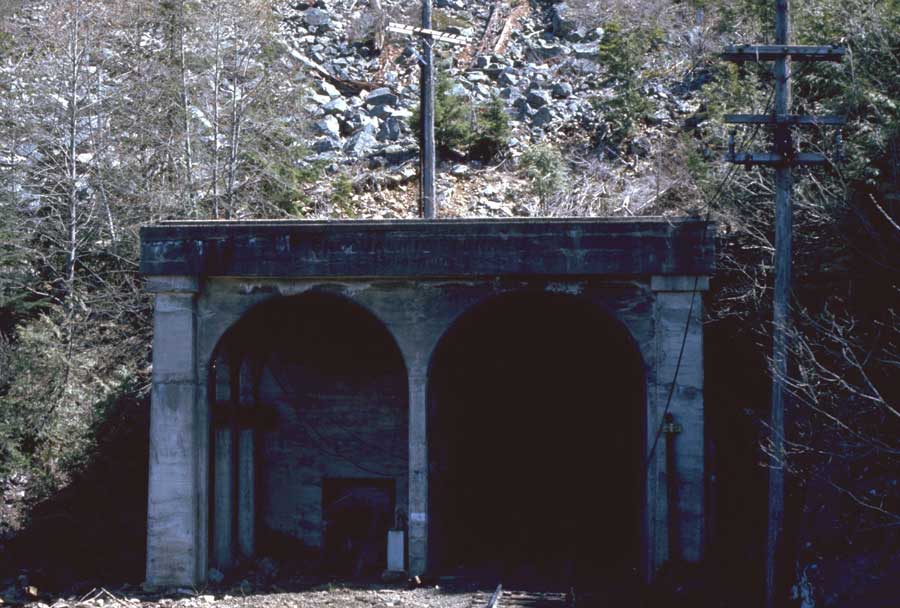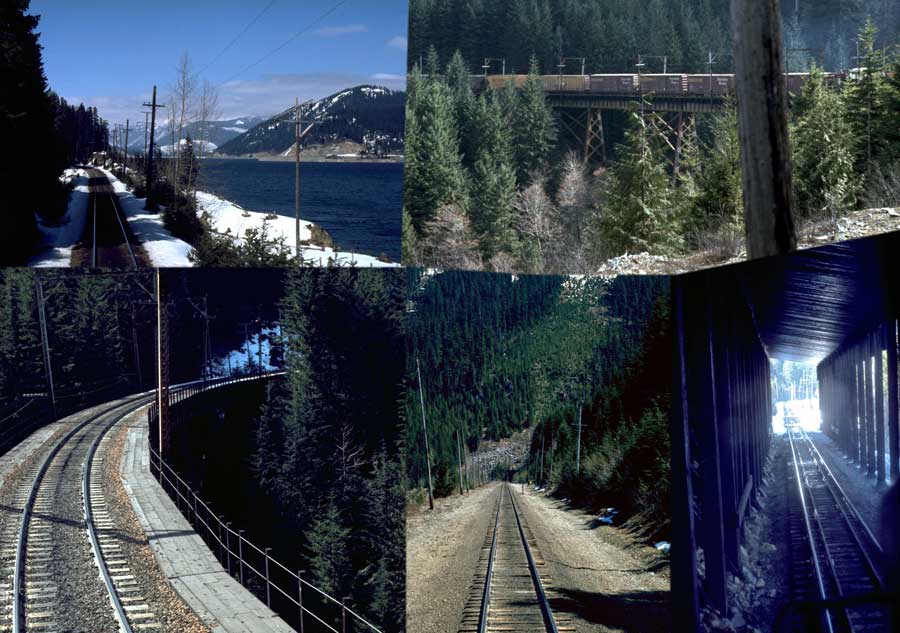MAIN LINE: SNOQUALMIE PASS
Cascade Range Summit Railroad Tunnels Compared
Stampede Pass Tunnel (2 miles) - Built by the Northern Pacific Railroad in the late nineteenth century, this tunnel was the first to be constructed. The eastbound and westbound grades are 2.2% compensated with the summit break inside the tunnel, not a happy situation for train handling. The low ceiling puts a crimp on traffic flow. Milwaukee Road detours I worked through this tunnel were devoid of our usual profitable auto transport business. The one Burlington Northern train I worked over this route, Train 175-6 (Auburn to Yakima), hauled mostly forest products and grain; the more valuable merchandise and auto traffic was sent via Steven's Pass.
Stampede Pass was closed in the early 1980's as redundant.
Snoqualmie Pass Tunnel (2 miles) - Built by the Milwaukee Road soon after the opening of the Pacific Extension in 1914, this tunnel sits at the top of the 20 mile 1.74% compensated eastbound grade from Cedar Falls (Rattlesnake Lake) up to Rockdale at the tunnel's west portal. The tunnel is level inside, and is level into Hyak at the east portal. The westbound grade from Cle Elum up to Hyak is an easy .7% compensated. There were no unusual train handling problems in the tunnel. With helpers, or lo-control ("slaves") cut into the length of an eastward train, the engineer typically throttled back head end power as the train entered the tunnel and regained level ground. By the east portal, the slaves (out of radio control in the tunnel) would be doing the bulk of the work. In the 1960's, with its continuing tradition of innovation ("America's Reso! urceful Railroad"), the Milwaukee Road completed the task of lowering the floors of all of its mainline tunnels in order to compete for tri-level auto rack traffic. While modern container trains would be right at home in Snoqualmie Tunnel, bicycle traffic clears the ceiling with room to spare! Burlington Northern acquired the Snoqualmie Pass route when the Milwaukee Road abandoned Lines West in 1980. Management under new Board Chairman Richard Bressler, formerly CEO of Atlantic Richfield Co., was focused on Wyoming Powder River coal hauling business, on Burlington Resources Co. (oil), on Plum Creek Co. (timber), on Glacier Park Co. (real estate), on anything other than strategic long range thinking about transcontinental rail freight traffic. Thus the State of Washington was offered the best railroad route through the Cascade Range for conversion to the misnamed "John Wayne Trail."
Steven's Pass Tunnel (7.9 miles) - The Cascade Tunnel was opened by the Great Northern Railway in 1929 and is considered one of world's great railway engineering feats. It reduced the climb over Steven's Pass and removed the avalanche danger of the former route. The damage to Great Northern's reputation from the Wellington snow slide disaster has been cited as an important factor in the decision to build the Cascade Tunnel. One can't help but wonder if the press of competition from the Milwaukee Road's better route was also a consideration.

Washington Division Time Table Special Instructions, 24 April 1977The 12.8 mile eastbound grade from Skykomish to the west portal at Scenic is 2.2% compensated. The 7.9 mile eastbound grade in the tunnel is 1.7%. The summit is at the tunnel's east portal, just west of Berne. The 7 mile westbound grade from Merritt to Berne is 2.2% compensated. At the east portal are two gigantic fans which provide westward ventilation. The fans are inside automatic tunnel doors which remain closed until a train enters the CTC block circuitry on the doors' approach. For eastward trains in the tunnel, this means the doors remain closed until the train approaches the east portal.

View East, West Portal Snoqualmie Tunnel at RockdaleIn my time at Burlington Northern, I came to dread the donning of respirators that signaled the start of our almost one hour adventure on the uphill eastward grade through the 7.9 mile mountain bore. On two occasions my train fell victim to tunnel induced locomotive overheating as each our four head end locomotives shut down in turn. This required backing out of the tunnel to Scenic.
Over the years, the railroad has been subject of millions in employee lawsuits over chronic, and sometimes fatal, health problems endemic to inhalation of the intense diesel exhaust in the tunnel. While the tunnel is lined with 21 oxygen equipped emergency "bays" marked from the westend by art deco numbered lights (the first seven or so bays also have escape exits to the old construction tunnel), the Company was late in providing respirators for train crews. On board emergency oxygen was not added until 1980.
The requirement that eastbounds wait 45 minutes at Scenic for a tunnel "flush" after westbound meets, puts a severe crimp into the capacity of the road. In recent years, traffic congestion over Steven's Pass forced Burlington Northern Santa Fe to reopen the Stampede Pass route. Meanwhile Iron Horse/Pioneer/John Wayne Trail (Olympian Hiawatha Trail) bicycles roll majestically over the best engineered railroad route through the Cascades.

COAST DIVISION
SEATTLE YARD- Survivin' the Night
- Puget Sound Barges
- Switchin' & Trampin'
- Flat Switching
- Black River Yard & The P.C.R.R.
- Road Extra Board
- Tacoma Roundhouse
- Tacoma Junction
- Joint Line: Superiority of Trains
- Joint Line: Automatic Block Signals (ABS)
- Mainline: Othello
- Mainline: Extra 194 West
- Mainline: Extra 156 East
- Mainline: Beverly Depot
- Mainline: Columbia River Bridge, Boylston Tunnel, Renslow Trestle
- Mainline: Snoqualmie Pass
- Mainline: Cle Elum
- Mainline: Work Trains and Wreckers
- South Line: Rule 99 Territory
- Burlington Northern Pacific Division Third Sub: Centralized Traffic Control (CTC)
- Portland Trains
- Hoquiam Turn
- Tacoma and Eastern Railway (12th Sub): Mineral Turn
- Tacoma and Eastern Railway (12th Sub): Morton Local
- Olympic Peninsula (14th Sub): Port Angeles to Portland
Join the Milwaukee Road Historical Association and MilWest